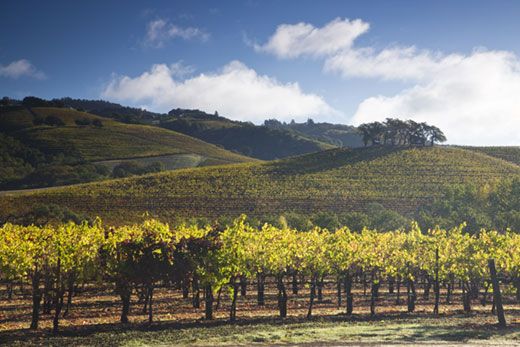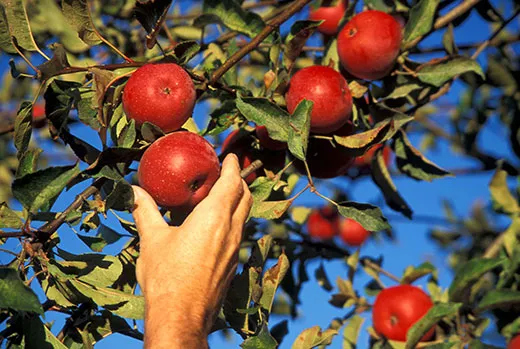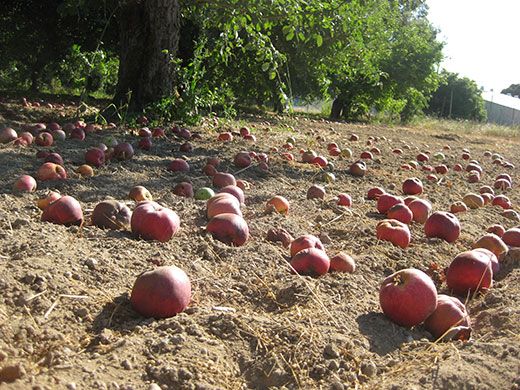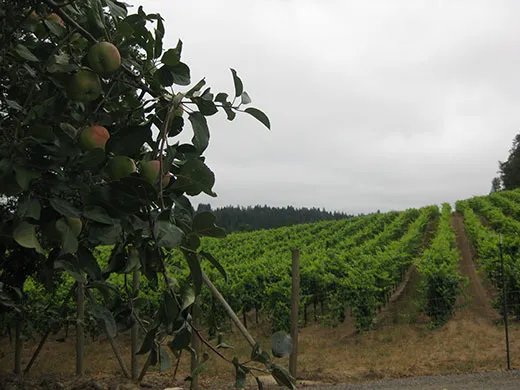California’s Disappearing Apple Orchards
In Sonoma County, apple growers battle against the wine industry and cheap Chinese imports
/https://tf-cmsv2-smithsonianmag-media.s3.amazonaws.com/filer/apples-Sonoma-County-California-631.jpg)
Sonoma County is among the most esteemed wine-growing areas in the world, but it used to be famous for a different crop. Located just north of San Francisco, this region of rolling hills, vast dairy spreads and conifer forests flanking the coast was once the heart of a thriving apple industry. In its heyday in the early and mid 20th century, more than 13,000 acres of apple orchards blanketed the county. These groves consisted of scores of varieties and supported hundreds of farmers.
But one by one, Sonoma County’s apple farmers are giving up. Though apples are the nation’s most popular fruit, they are relatively worthless in Sonoma County, where wine grapes draw more than ten times the price per ton and where imported apples on local market shelves are often cheaper than locally grown ones. Today, fewer than 3,000 acres of apple trees remain countywide, and just one processing and packing plant is still in business.
“The industry as a whole is almost finished,” says Dave Hale, who began growing apples three decades ago on the outskirts of Sebastopol, a hub of artists, hippies and farmers. Since then, Hale has watched the industry shrink steadily. In 2010, Hale didn’t even bother harvesting his crop of Rome Beauties. The wholesale price for flawless, tree-ripened fruit was barely 6 cents a pound—$125 per ton, two grand an acre. The sodden, spoiled fruits of last year’s fruit linger on the ground.
Hale’s neighbors have already given up. Standing at the southern edge of his 20-acre orchard, Hale peers through a wire fence at the adjacent property. Among the trees, the weeds stand knee-deep; the orchard was last harvested in 2008. New owners are planning to remove the apple trees and replace them with grapevines. This fate is a tirelessly common one in the county, where 56,000 acres of wine grapes crawl up trellises staked into the earth. On the north side of Hale’s farm, the land has already been converted; an apple orchard until seven years ago, it now bears a bucolic sign at the front gate with calligraphic letters reading, “Susanna’s Vineyard.”
Wine grapes are where the money is, and with a ton of Sonoma County grapes going for $2,000 on average, the incentive for apple farmers to switch to grapes or sell out is huge. Farmer Ted Klopt succumbed to this temptation ten years ago, when he was receiving just $120 per ton of apples. He planted his orchards in Pinot Noir grapes. He has no regrets. He says he grew many kinds of apples, which ripened at different times between July and November, keeping him and his crew working steadily throughout the autumn. By contrast, his grapes, when deemed ready for the crush, can be stripped from the vines all at once. “Grapes take less work,” Klopt says. “I can harvest in one or two days instead of over four months, and I get more money.”
The local wine industry’s rise has helped spur the apple industry’s fall, but another force is also at play: global competition and the bizarre economic dynamic that can make goods produced half the world away cheaper than those from down the road. Chile, New Zealand and Australia all export either fresh apples or juice concentrate to the United States. But no nation now plays as pivotal a role in the global apple industry as China. In its northwestern provinces on and around the Loess Plateau, a colossal expansion of apple orchards has occurred since the early 1990s, when China produced about the same amount of apples as America. Today, Chinese apples outnumber American apples seven to one and in 2010 amounted to 36 million tons–roughly half of all apples grown on earth. What’s more, they’re dirt cheap–some less than 2 cents a pound, according to a 2010 U.S. Department of Agriculture report.
China’s fresh apples are tumbling into foreign markets worldwide, undercutting prices of locally grown fruit. In Australia, the first Chinese apples since the 1920s entered the country in January 2011, raising objections from local industry leaders and farmers, who urged shoppers not to buy them. China’s apples are barred from import into the United States, but not its apple juice concentrate, which is what is crushing Sonoma County’s farmers. This product, often shipped frozen, is the basic ingredient of much of the world’s apple juice and other juice products. China is now the world’s largest exporter of apple juice concentrate, and its biggest buyer is the United States, where two-thirds of all apple juice consumed comes from China.
Lee Walker, a third-generation owner of one of the oldest apple farms in Sonoma County, remembers when the apple business first changed dramatically. “In the 1980s, China started exporting juice concentrate and selling it for half of our price,” Walker says. “We lost our floor.”
The facilities that bought and processed his apples and those of other Sonoma County farmers went under as national produce companies turned increasingly to the cheap concentrate from China, and by 2004, Manzana Products Company, a large gray aerodrome-like facility, was the last processor in town.
Elsewhere, along the roadways and bike paths that cut through the area’s woods, relics of the apple-growing glory days remain: A pair of rail cars once used by an apple shipper lie in a field; a cluster of warehouses, once home to an apple-processing company, contain steel tanks full of wine. And in a tidy suburban cul-de-sac on Gail Lane, old apple trees sprout here and there from the trimmed green lawns, reminders of the day when this was a 20-acre orchard.
Farmer Gene Calvi lives here. While he has maintained the six acres of trees behind his home, his neighbors have removed nearly all their apple trees over the past 30 years and replaced them with neat hedges, rock gardens and grassy lawns. Calvi thinks that Sonoma County’s apple industry may be doomed. “I just don’t see what can keep it together,” he says. Calvi notes that Manzana was recently offering farmers $45 per ton for bruised or otherwise damaged “vinegar apples.”
“It costs me about $40 per ton to pay my sons to clean them up,” Calvi says. “That leaves me five bucks per ton.”
The juice price, he says, is usually about $150 per ton of apples. The best price of all, though, comes from fresh, undamaged apples sold directly off the farm, which can draw a dollar or more per pound—grape prices, no less. “The only thing is, you need to bring in the shoppers,” Calvi says, “and I just can’t, so I sell for juice.”
Other area apple farmers are also innovating to survive: They are selling their fruit fresh as often as possible to draw the best prices, with self-pick arrangements, often announced via cardboard signs along the highway, increasingly common. Many farmers have become certified organic to merit a still higher per-pound price.
Paul and Kendra Kolling, who manage and harvest 75 acres of organic apple trees countywide and own the juice and sauce label Nana Mae’s Organics, simply can’t sell all their fruit and products to local buyers. So two years ago, the pair began selling their apple sauce and juice straight back across the Pacific Ocean to Taiwan, where a small niche of moneyed consumers eagerly seeks higher-end food products.
“It’s crazy what’s happened,” Kendra Kolling says. “Everyone here is buying Chinese apples, and so now we’re selling these local apples back to Taiwan because we have to.”
In some parts of the world, apple juice means hard cider, a fermented drink usually containing 5 to 10 percent alcohol. Englishman Jeffrey House remembers first visiting Sonoma County in the early 1990s. He was struck by the extensive apple orchards, which reminded him of home. “You could go all the way to the coast in those days and not see any grapevines,” he recalls. “It looked just like England out here with all these apples, and I couldn’t believe that no one was making cider.”
So in 1994 he settled here and began making his own under a brand called Ace. He used Granny Smith, Gravenstein, Jonathan and other varieties from local farmers. Even as late as 2004, House says, he was using all locally grown fruit.
But things changed. Ace, now located in an industrial lot beside Gravenstein Highway, has grown tremendously, by 48 percent last year alone. Local apple production, meanwhile, has steadily diminished, and today, to keep the fermentation tanks filled and the bottling line in motion, House mostly buys apples from, as he says, “other places.” And so the delivery trucks come regularly from lands far away. Just southeast of Sebastopol, the trucks enter the old apple country, past orchards littered with fallen fruits, overgrown with weeds and even slated for removal, past Apple Blossom Lane, and finally, with a hard left turn, in through the chain-link gate of the warehouse complex that Ace Cider calls home.
“Local apples cost too much,” House says. Still, the circumstances have him a bit mystified. “The apples are falling on the ground out there,” he observes, “and here we have to buy apples from other places. It defies economics.”
But at another Sonoma County company called Murray’s Cyder, owner Wayne Van Loon is developing a different sort of brand. He is paying local apple growers about three times the standard rate for their apple juice and calls it his “mission in life, besides blessing the world with cider, to save the apples” of Sonoma County–a big goal for such a tiny enterprise. In 2010, Van Loon bottled up just 350 cases of 750-milliliter bottles, each of which he corked by hand with a manual press. That year’s production used the juice of about 600 trees, Van Loon guesses, but the company is growing fast. This year, Van Loon expects to double the volume while focusing on using traditional English cider apple varieties–fruits with names like Golden Russet, Brown Snout, Liberty and Stayman Winesap.
Such varieties, though rare, are available at scattered locations throughout Sonoma County, but Van Loon now needs more apples, and for several farmers, Murray’s Cyder could represent a stable future income. Working under supply agreements with Van Loon, they are now planting apple saplings by the hundreds. In several years the trees will bear lumpy, inedible fruits good for little else than making cider, and—in a land of valuable Pinot Noir grapes and cheap imported apples—the venture is clearly a gamble. But sales reports from companies as large as Ace and as small as Murray’s show that interest in apple cider is growing, and to bank on a future in apples in Sonoma County might even be a gamble worth making.
Alastair Bland blogs about adventure travel for Smithsonian’s “Off the Road.”
Planning Your Next Trip?
Explore great travel deals
Smithsonian magazine participates in affiliate link advertising programs. If you purchase an item through these links, we receive a commission.
/https://tf-cmsv2-smithsonianmag-media.s3.amazonaws.com/accounts/headshot/Off-Road-alastair-bland-240.jpg)





/https://tf-cmsv2-smithsonianmag-media.s3.amazonaws.com/accounts/headshot/Off-Road-alastair-bland-240.jpg)